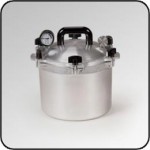Home Pressure Canner Directions: How They Work, Instructions and Tips to Using Them!
Pressure Canning Information, Explanations, Supplies and Related Items
If you’ve tried some water bath canning; making jams or applesauce, you may have been tempted to can some other vegetables from you garden. If they are low-acid (and pretty much all vegetables other than tomatoes are low acid, not counting pickles – to which vinegar, which is acidic – is added) you’ll need a pressure canner! And you definitely need a pressure canner for anything containing any meat. There are limits to what you can safely can at home, though. Home canning of dairy is not recommended (USDA, Ball, etc.) , even with a pressure canner.
The open water bath canners can’t get water any hotter than 212 F and that’s not hot enough to kill the bacteria that can grow in low acid foods. A pressure canner hits 240F which allows for home canning of many more foods, like corn, beans, meats, etc.).
Why do I need to use a pressure canner to can most vegetables?
A water bath canner is fine for acidic fruits and vegetables, such as jams, jellies, applesauce, apple butter, and tomatoes, but for almost all other vegetables, like carrots, squash, green beans, squash, corn, okra, etc. you’ll need a pressure canner.
Quoting from the “Ohio State University Extension’s Fact Sheet”:
“Pressure canning is the only safe method for home canning vegetables. Clostridium botulinum is the bacterium that causes botulism food poisoning in low-acid foods, such as vegetables. The bacterial spores are destroyed only when the vegetables are processed in a pressure canner at 240 degrees Fahrenheit (F) for the correct amount of time.
Clostridium botulinum is the bacterium commonly found in vegetables and meats. It is harmless until it finds itself in a moist, low-acid, oxygen-free environment or a partial vacuum. In other words, a sealed jar! Under these conditions, the bacterium can grow and produce toxins dangerous to people and animals. Yes, we have ALL heard about someone’s grandmother who canned without a pressure canner and lived to 90. And we all know people who smoked 2 packs a day and lived to 90. But neither is smart to do, and the odds will catch up with most people. You’ll literally gamble with your life when you eat low acid foods that were canned use the open water bath, rather than pressure canning method.
Do not process (low acid) vegetables using the boiling water bath because the botulinum bacteria can survive that method.
How does a pressure canner work?
Modern pressure canners are lightweight, thin-walled aluminum or stainless steel kettles. Most have twist-on lids fitted with gaskets. There is still one or two that have screw-down knobs around the lid on the canner. They have removable racks, a weighted vent port (steam vent), and a safety vent. They also have either a dial gauge for indicating the pressure or a weighted gauge (which both regulates the pressure and indicates, by rattling). Pressure canners can usually handle either one layer of quart or smaller size jars, or deep enough for two layers of pint or smaller size jars.
Unlike a water bath canner, the jars do not need to be completely covered with water. The directions that came with the pressure canner tell you how many cups of water to add in order for it to generate the right amount of pressure. You vent the pressure canner a considerable length of time while the water boils (with the jars in and the lid on). This causes steam to push out all the air. So the jars are in a space filled with only boiling water and steam. In theory, both will have the same temperature, which will be 240 F, substantially high than 212 F of an open water bath canner, due to the increased pressure. And since there is no air, just water vapor, the heat will be easily conducted to all sides of the jars.
General Instructions for Home Pressure Canning (check out the video below)
Ok, you’re thinking, I have loads of vegetables from my garden that I could can for the winter, maybe I should get a pressure canner; but are they difficult to use? Not at all; here are typical step-by-step directions (of course, always follow any specific directions that come with any pressure canner you buy, but this will work for most!). And if you are missing the manual for your pressure canner, click below for instruction manuals for our popular pressure canners:
- Put the canner on the stove on the largest burner.
- Put the rack (usually a metal plate with holes in) into the canner and 2 to 3 inches of hot water into the canner.
- Place the filled jars (with the lids and rings on) fitted with lids, on the jar rack in the canner.
- Put the canner lid and seal it down. Leave the weight off the vent port (or petcock).
- Turn the burner up to its highest position. Heat until the water boils and steam exits strongly from the open vent port (or petcock). While maintaining the high heat setting, let the steam flow (exhaust) continuously for 10 minutes.
- Allow the canner to vent for the specified time (usually 10 to 15 minutes), then put the weight or on (or close the petcock). The canner will get up to pressure in just a few minutes.
- Once the pressure gauge indicates that it has reached the desired pressure (often 11 lbs.) start timing!
- Adjust the burner to maintain the desired pressure, as shown on the gauge. If there is now gauge, the weight should jiggle a couple of times per minute, of course, check the manufacturer’s directions.
- At the end of the processing time (often in the range of 5 to 15 minutes; it varies for different foods altitudes and jar sizes), turn the heat off and allow the canner to cool down until the pressure is vented!
- Lift off the weight open the top and remove the jars! Carefully place the jars onto a towel or cake cooling rack, leaving about an inch of space between the jars. Avoid placing the jars in cold or drafty areas. Let the jars cool overnight (or about 8 hrs.)
Tips
Don’t let the pressure drop during processing – if it starts to go down, turn the burner up just a bit.
If the pressure goes below the recommended amount, increase the heat to bring the canner back to pressure. Start the timing of the process over from the beginning.
If you are located over 1,000 ft. above sea level; read the canner’s instructions to increase the canning time or pressure.
Be sure to vent the canner with steam exiting for the specified length of time to prevent air becoming trapped in the closed canner. Trapped air lowers the temperature obtained for a given pressure and results in under processing. Most pressure canners must be vented 10 minutes before they are sealed and pressurized.
To properly vent a canner, leave the vent port (steam vent) uncovered after you fill the canner and lock the canner lid in place. Heat the canner on high until the water boils and generates steam that can be easily seen escaping through the open vent port. When a visible plume of steam continuously exits the canner, start the timer for 10 minutes. After 10 minutes of continuous steam, you can close the vent (usually by putting the weight on it) to begin pressurizing the canner.
| Canning all sorts of fruit and vegetables, even meat with a pressure canner it’s easy. And although a pressure canner could costs some money, they last a lifetime, and your children and grandchildren may be using it. You can also find free information from the USDA in this PDF file (it will take a while to load!) about selecting and using canners here! |



